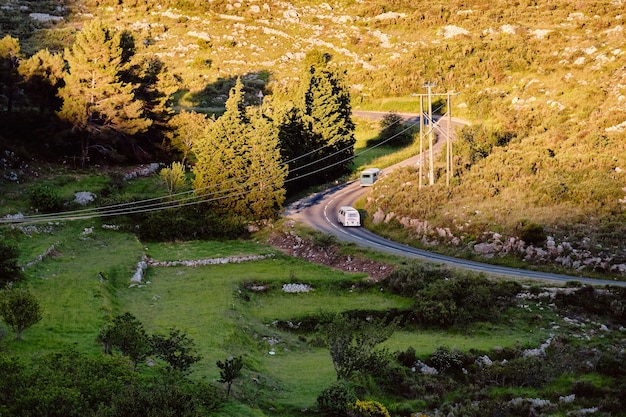
Our first day of hiking in the Dolomites was relatively easy, as we tackled the gentler slopes of the Rosengarten range in South Tyrol. However, Day 2 was much more challenging. We scrambled over the Coronnelle pass and carefully navigated down the treacherous scree slopes on the other side. After pushing through a surreal, lunar-like landscape, we finally reached our next mountain hut. There, we enjoyed a well-earned beer on the terrace as the evening sun turned the mountains pink.
Our first night at KolnerHütte was quite enjoyable. We had a hearty supper in a cozy dining room decorated with Tyrolean touches and red-checked tablecloths. The meal included pasta, gammon and potatoes, and tiramisu, all washed down with beer. We retired early to our bunks in an 8-bedroom dorm. It wasn’t the best night’s sleep, as I wasn’t used to sleeping so close to six middle-aged Belgian men who wished each other good night like a chorus from The Waltons.
The next morning, we were up early with our rucksacks packed and poles ready. From the terrace of the Rifugio, I watched the grey silhouettes of mountain ranges, layer upon layer, with the pink glow of sunrise behind them. The air was cold as the sun gradually lit up the valleys below, revealing patches of lighter green and a sprinkling of houses.
I was nervous about the next section of the route. To avoid a two-hour detour around the Rosengarten range, we chose the shorter but steeper route over the Coronnelle Pass. Immediately above the hut was a 20-meter section where we had to climb hand over foot, using metal cables and footholds fixed in the rock. It reminded me of my first Via Ferrata in South Tyrol, but this time we had no helmet, harness, or karabiners to secure us.
After the initial section, the path became slightly more secure, winding upwards through a rocky landscape. Ahead, there seemed to be only a vertical rock face, which I hoped we wouldn’t need to climb. A turn in the path revealed a break through to the top, secured by wooden logs, metal cables, and toe holds. After an hour of climbing, we emerged at the top of the pass, greeted by a panoramic view of valleys and peaks.
We rested for a while, enjoying an eagle’s eye view of our next stop, Rifugio Vaiolet. Although it looked close, it took another hour and a half of navigating narrow paths and slippery shale to reach it. Once there, we settled on the sunny terrace for a cool lemon soda.
From the terrace, we saw what looked like a line of ants—people coming up from the valley, likely dropped off by bus or cable car. As we continued our hike above the refuge, the path broadened, and we walked through a craggy, grey, and barren lunar landscape with only small patches of grass. The rocky peaks around us had a pink hue that would turn even rosier when lit by the setting sun. The name Rosengarten comes from the rose garden owned, according to legend, by King Laurin, the dwarf king who ruled this quartz kingdom.
I wondered which direction we would follow next, as all I could see was a narrow trail high above us leading towards another pass. We saw a flag on the rock above and turned the path to see the refuge of Grasleitenpasse hanging on the side of the mountain. We gratefully shrugged off our rucksacks and settled on the wooden benches for lunch, although the air was cool at this altitude.
Despite the remote location, the food was excellent. I ordered a hearty bowl of vegetable soup, while my friend Julia enjoyed cheesy polenta with ham and rocket salad. A helicopter circled overhead and flew into the next valley, making me wonder if it was sent to rescue someone. Some remote refuges in the Dolomites can only be reached by walking or by helicopter for supplies and emergencies.
From the Rifugio, the path continued downhill into a bowl in the mountains filled with rock and no vegetation. The scree was very slippery, and we had to be careful not to dislodge rocks onto walkers coming up the slope. Down the side of the mountains were rivers of scree left by rockfalls and jagged peaks above the moraine, where a glacier must have passed through millions of years ago.
From the bowl in the mountains, we reached an opening where we could glimpse the green valley ahead. The path wound along the side of the mountain, with a stream rushing between grey rocks colored by patches of sulfur-yellow lichen. Before long, we spotted our next refuge below us, a large yellow building set at the head of the valley with a few cute goats grazing nearby.
We received a friendly welcome at Rifugio Bergamo, which had served as a base for gentleman mountaineers in the last century. The dining room was atmospheric, with wooden paneling and old climbing photographs. We had a cute room of our own with wooden beds and check duvets. Before supper, we sat on the terrace, basking in the last of the evening sun with a beer among boxes of bright red geraniums, and glimpsed the valley where we would head the next day.
In my next article, I’ll write about our walk to the next hut along a grassy plateau and our precipitous descent to the valley for a welcome return to the lovely Hotel Cyprianerhof. If you have any questions about hiking in the Dolomites, please leave them in the comments for me to answer.